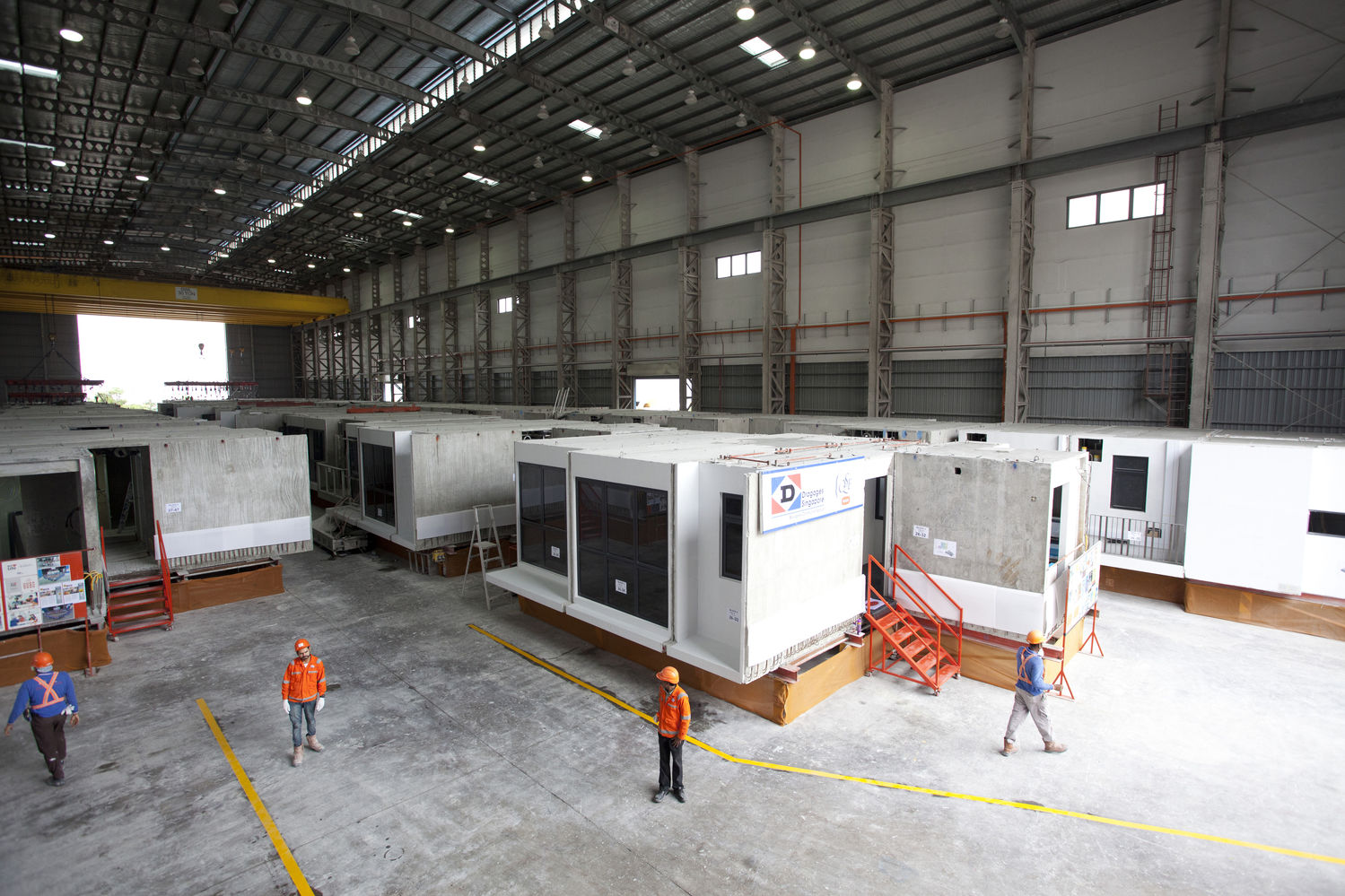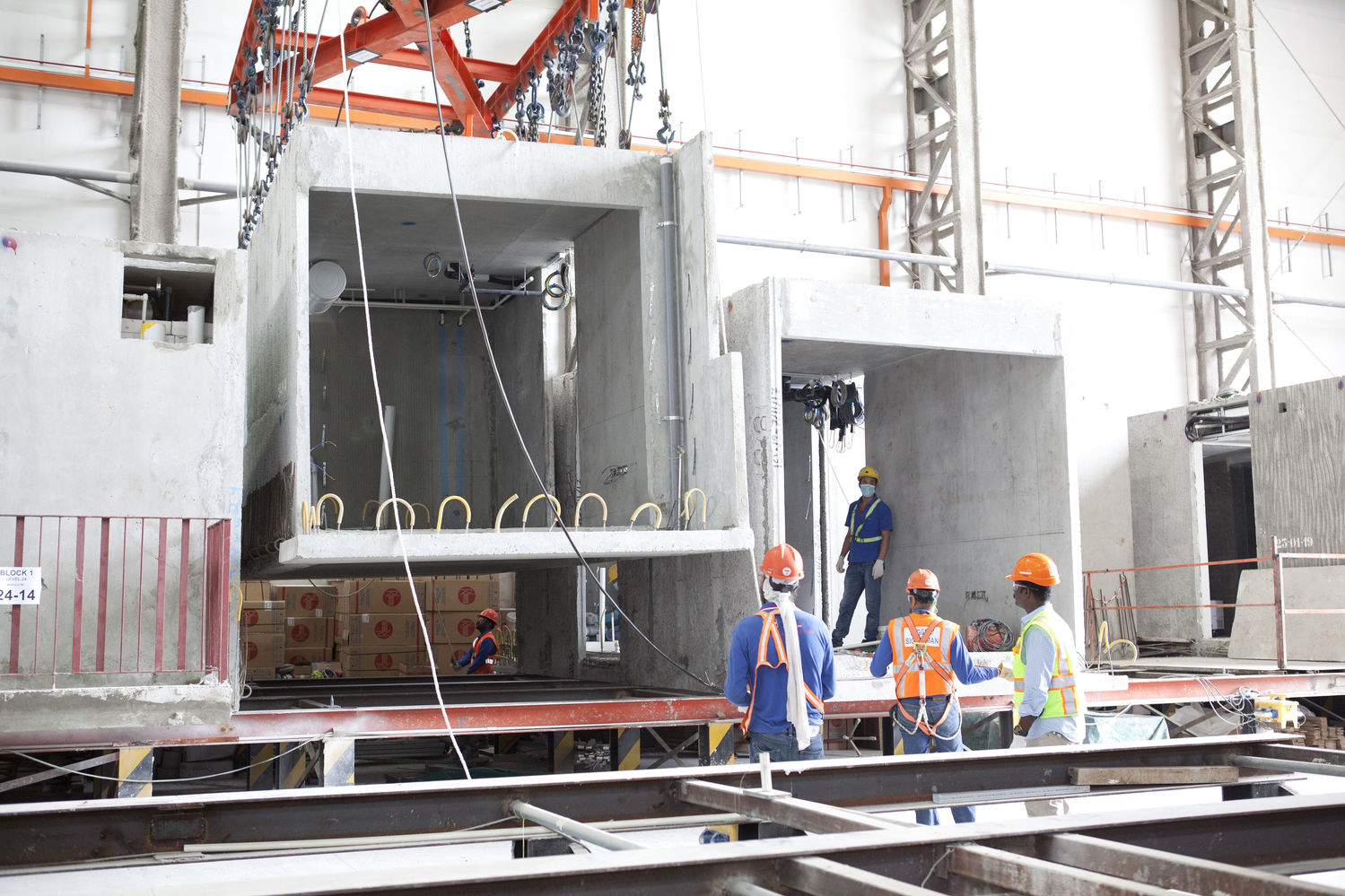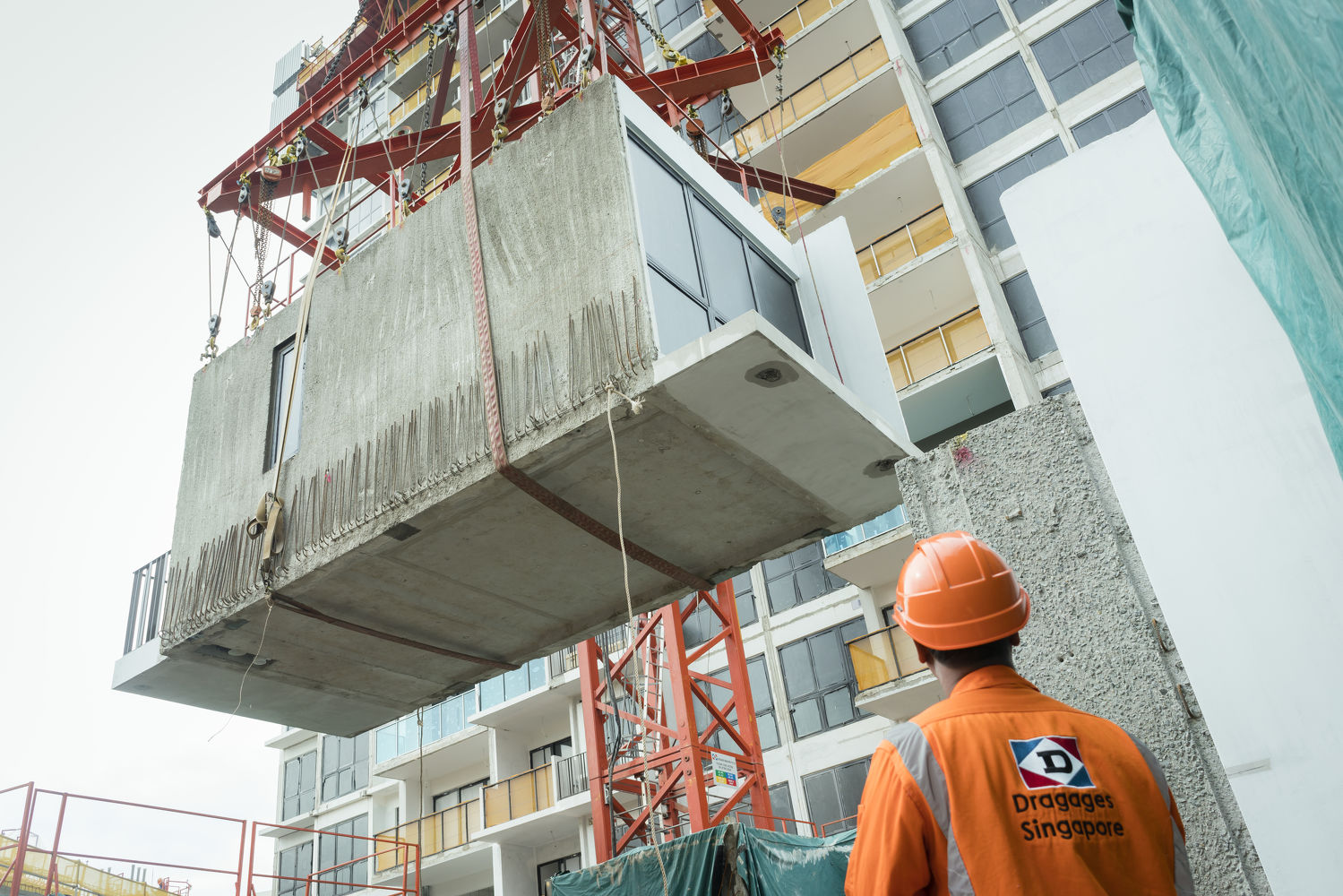Dragages Singapore: ‘Game-changer’ in modular construction
By Timothy Tay
/ EdgeProp Singapore |
Standing at 140m tall, the 40-storey residential twin towers of The Clement Canopy private condominium at Clementi Avenue 1 are considered the world’s tallest concrete modular towers using prefabricated prefinished volumetric construction (PPVC) method. The towers contain a total of 505 residential units that were fully sold and completed in 1Q2019. The keys have been handed over to the owners, and some residents have already moved in.
Jointly developed by Singapore-listed UOL Group and United Industrial Corp (UIC), The Clement Canopy was completed about six months ahead of the original schedule of 4Q2020.
Using the conventional construction method, the towers would have taken 30 to 36 months to complete. With the PPVC method, construction time is reduced to 24 to 30 months, which means a 20-30% time-saving, said Pierre-Eric Saint-André, deputy CEO for Bouygues Bâtiment International and CEO for Asia Pacific at a press conference in Singapore on June 27.
Advertisement

(From left) Khor Yew Chai, director of PPVC Dragages Singapore; Pierre-Eric Saint-André, deputy CEO for Bouygues Bâtiment International and CEO for Asia Pacific; and Julien Esch, managing director of Dragages Singapore (Picture: Samuel Isaac Chua/EdgeProp Singapore)
Considered a world leader in modular construction, Bouygues Bâtiment International is the parent company of Dragages Singapore, the construction firm that built The Clement Canopy. Bouygues Bâtiment International is a subsidiary of Paris-headquartered French industrial group, Bouygues Construction, which was founded in 1952. It had 129,000 employees as at 2017, with group turnover and income of €12.4 billion and €1.5 billion respectively in 2018.
Cost savings and scale
Since November 2014, Singapore’s Building and Construction Authority (BCA) has stipulated that selected sites offered in the Government Land Sales (GLS) programme need to adopt the use of PPVC for at least 65% of the total constructed floor area within residential developments.
For instance, four sites offered for sale under the GLS programme this year came with a PPVC requirement. These were the private condo site at Clementi Avenue 1, where a joint venture between UOL and UIC emerged as the top bidder with a bid of $491.3 million ($788 psf per plot ratio or ppr) on July 3; as well as the sites at Tan Quee Lan Street, Bernam Street and one-north Gateway.

The Clement Canopy is jointly developed by Singapore-listed UOL Group and United Industrial Corp (Picture: Dragages Singapore)
In more mature markets like Australia, the UK or the US, there is no difference in cost between modular and conventional construction, says Saint-André. “In Singapore, PPVC is 5-10% more expensive because we’re still at the start of the learning curve,” he adds. “It’s a question of scale: We need [the other players] in the supply chain to move with us and to improve. Our objective is to be a game-changer in the industry and to do that means to be able to build at a lower cost. I believe in the very near future, it will be better.”
Benefits of PPVC
Besides cost and time savings, modular construction also benefits the environment. The Clement Canopy, for example, is located next to Nan Hua High School and NUS High for Science and Mathematics. “When we started piling, it was quite painful,” relates Julien Esch, managing director of Dragages Singapore. “The headmasters of the schools would call and ask us to do something about the noise. We said we’d try but we are not magicians. But as soon as piling was completed, there were no more complaints because modular construction requires fewer heavy-load trucks and there is almost no noise during assembly on-site.”
In modular construction, the carcass of the building and the modules are completed in an off-site factory before they are transported to the site and assembled. “It’s just like building with Lego,” adds Esch. Hence, thereafter, lifting operations on-site are less noisy and dusty, he explains.
Advertisement

Concrete modules built in Malaysia are transported to the Dragages factory in Jurong Port where 80% of their interior fittings are installed (Picture: Samuel Isaac Chua/EdgeProp Singapore)
A second benefit of modular construction is, therefore, the assurance of quality, with up to 85% of the interior finishings and fittings in each module worked on in a controlled environment in a factory. This includes plumbing; tiling and waterproofing works; wall finishes and painting; installation of electrical outlets, air-conditioning units and door and window frames; as well as wooden flooring, kitchen cabinets and bathroom units which are prefinished and completely fitted out into modules before they arrive at the development’s construction site. “As such, we can monitor the work and control the outcome,” says Esch.
Sports Hub and beyond
Dragages has been in Singapore for 35 years. Its first project was the Newton MRT Station on the North-South Line completed in 1984. The firm was also involved in the construction of iconic projects such as the Sports Hub, which was completed in 2014.
In the same year, Dragages built the Crowne Plaza Changi Airport hotel extension using PPVC. All 252 new hotel rooms in the extension were installed over a period of just 28 days. The firm was also behind the construction of the ultra-luxury 34-unit Sculptura Ardmore, which features cantilevered private pools, completed in 2014. “Our core business is in building high-end, high-tech buildings,” says Esch.
The first large-scale residential development to use PPVC in Singapore was City Developments Ltd’s 638-unit executive condo, The Brownstone in Sembawang, which was completed in 2016.
Prefabricated, prefinished
The Clement Canopy involved the construction of 1,899 modules in total. These were precast in a yard in Senai, Malaysia, before being transported across the Tuas Second Link to the Dragages factory in Tuas. After being fitted out or pre-finished, they were then installed on-site within one year, with topping-out taking place three months later.

Prefinished modules are driven to the development site, hoisted up and assembled together to form different unit types (Picture: Dragages Singapore)
Since the completion of The Clement Canopy, Dragages has begun working on three new residential developments, including those launched for sale last year such as the 613-unit The Garden Residences at Serangoon North View by Keppel Land and Wing Tai Holdings; and the 805-unit Park Colonial adjacent to Woodleigh MRT Station by Chip Eng Seng Corp.
Advertisement

Dragages is also the appointed construction company for upcoming projects such as the mixed-use development with residences at Uptown @ Farrer by Low Keng Huat on Perumal Road; the Grade-A office and integrated commercial development CapitaSpring at Raffles Place by CapitaLand Commercial Trust; the Bideford Hills mixed-use development with commercial, retail and residences by SIN Capital Group located off prime Orchard Road; as well as the new BCA Academy on Braddell Road.
‘Zero defects’
According to Esch, Dragages is involved in the construction of most of the developments that require PPVC. Anticipating a growing demand for PPVC modular construction in Southeast Asia, the construction firm opened a new factory at Jurong Port, which began operations last November. This means prefabricated modules built in Malaysia can now be transported by barge directly to the factory at Jurong Port instead of by road.
During a press tour of the new factory at Jurong Port, Dragages demonstrated how the prefabricated modules destined for The Garden Residences were pre-finished for two- and three-bedroom units. “We can process different modules for about three different projects in this factory,” says Khor Yew Chai, Dragages Singapore director of PPVC. “On top of these modules for The Garden Residences, we will also prefabricate modules for Park Colonial and Uptown @ Farrer here.”

Modules manufactured in Malaysia can be shipped to a Dragages Singapore factory in Jurong Port (Picture Dragages Singapore)
Unlike conventional construction, modular construction is similar to “assembling a Swiss watch”, says Khor. “There is no way to compensate for imperfectly installed modules once they are fixed in place.”
Dragages Singapore is recognised for its “zero defects” products for modules that leave its factories, says Saint-André.
Singapore is the R&D hub for Dragages to perfect its modular construction methods and expand to the rest of the region. “Our access to Jurong Port means that we can ship modules built in Singapore to sites in Indonesia, the Philippines, Thailand, Myanmar, and even South Korea and Japan,” continues Saint-André. “We want to remain the top player in the world in terms of high-quality modular construction.”

1 of 4

2 of 4

3 of 4

4 of 4

1 of 4

2 of 4

3 of 4

4 of 4
https://www.edgeprop.sg/property-news/dragages-singapore-%E2%80%98game-changer%E2%80%99-modular-construction
Tags: |


Follow Us
Follow our channels to receive property news updates 24/7 round the clock.
Subscribe to our newsletter
Advertisement
Advertisement
Advertisement
Search Articles